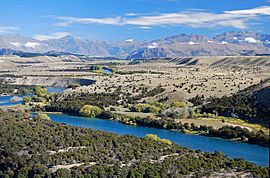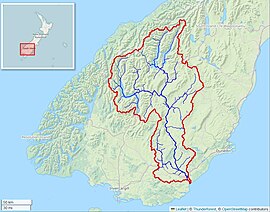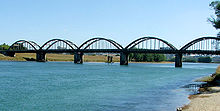Clutha River
| Clutha River Mata-Au, Molyneux | |
|---|---|
 Upper Clutha Valley, looking upriver toward theSouthern Alps | |
 Clutha River basin (Interactive map) | |
| Etymology | Mata-au: current in the water. Clutha: fromCluaidh,theScots Gaelicname for theRiver Clyde |
| Native name | Mata-Au(Māori) |
| Location | |
| Country | |
| Region | |
| Settlements | Wānaka,Cromwell,Clyde,Alexandra,Roxburgh,Balclutha |
| Physical characteristics | |
| Source | Mount Brewster |
| • location | Southern Alps |
| • elevation | 1,540 metres (5,050 ft) |
| Mouth | Pacific Ocean |
• coordinates | 46°21′S169°48′E/ 46.350°S 169.800°E |
• elevation | Sea level |
| Length | 338 km (210 mi) |
| Basin size | 21,000 km2(8,100 sq mi) |
| Discharge | |
| • average | 614 m3/s (21,700 cu ft/s) |
| Basin features | |
| Progression | Makarora River→Lake Wānaka→ Clutha River →Pacific Ocean |
| Tributaries | |
| • left | Hāwea River,Lindis River,Manuherikia River,Beaumont River,Tuapeka River |
| • right | Cardrona River,Kawarau River,Pomahaka River,Waiwera River |
| Waterbodies | Lake Wānaka,Lake Dunstan,Lake Roxburgh |
| Islands | Inch Clutha |
TheClutha River(Māori:Mata-Au,officially gazetted asClutha River /Mata-Au) is the second longestriverinNew Zealandand the longest in theSouth Island.It flows south-southeast 338 kilometres (210 mi) throughCentralandSouth OtagofromLake Wānakain theSouthern Alpsto thePacific Ocean,75 kilometres (47 mi) south west ofDunedin.It is the highest volume river in New Zealand, and the swiftest, with a catchment of 21,000 square kilometres (8,100 sq mi), discharging a mean flow of 614 cubic metres per second (21,700 cu ft/s).[1][2]The river is known for its scenery,gold-rushhistory, and swift turquoise waters. A river conservation group, theClutha Mata-Au River Parkway Group,is working to establish a regional river parkway, with a trail, along the entire river corridor.
Geography
[edit]
The ultimate source of the river is at the head of theMakarora River,close to the saddle of theHaast Pass,which flows into the northern end ofLake Wānaka.The southern end of the lake drains into the nascent Clutha close toAlbert Town,where it is met by its first main tributary, theHāwea River,the outflow of Lake Wānaka's twin,Lake Hāwea.Close downstream it is fed by theCardrona River.
The river flows swiftly through the Upper Clutha Valley between ancient glacial terraces, negotiating a long section called the 'Snake'. NearLuggateis a rare switchback feature called the "Devil's Nook". The river narrows as it passes through the Māori Gorge at Queensberry. Below another tributary, theLindis,the river widens again as it entersLake Dunstan,created by the massivehydroelectricdam at Clyde.
Fifty kilometres south of Lake Wānaka, the Clutha reaches the town ofCromwellat the junction with theKawarau River.The area was substantially altered when the Clyde Dam project was commissioned in 1992. Before the Clyde Dam, this river junction was known as the Cromwell Junction,[3]renowned for the difference in colour between the two rivers’ waters.[4]
Below the Kawarau junction, the river flows southeast through the inundatedCromwell GorgetoClydeand nearbyAlexandra,where it is joined by the waters of theManuherikia River.South of Alexandra the river widens again to formLake Roxburgh,another artificial lake, behind theRoxburgh Dam.In 1956, the hydroelectric reservoir flooded the Roxburgh Gorge and several large rapids including the Molyneux Falls and the Golden Falls. The town ofRoxburghsits close to the river, 120 kilometres (75 mi) downstream from Lake Wānaka.
From Roxburgh the river continues southeast past the towns ofEttrick,Millers Flat,andBeaumont,before flowing through the Rongahere Gorge, admired for its nativebushcorridor and for the Birch Island native tree reserve. Beyond here, the river is met by theTuapeka Riverat Tuapeka Mouth. At this point the river turns southward, before being met by its last major tributary, thePomahaka River,which joins the Clutha 30 kilometres (19 mi) from the coast. The river passes the town ofBalcluthabefore widening into the Clutha delta which contains the large flat island ofInch Clutha.Here the river divides into twodistributarybranches. TheMatau(northern) branch flows pastKaitangata.The southern branch is called theKoau.Both branches flow into the Pacific Ocean atMolyneux Bay.
River flow
[edit]The average discharge of the Clutha is around 614 cubic metres per second (21,700 cu ft/s),[1]comparable to many much larger rivers. This heavy flow, combined with the relatively small size of the river in global terms, makes the Clutha notoriously fast-flowing. It is often listed as one of the world's most swiftly flowing rivers, alongside Australia'sMacleayandFitzroy Rivers,theAmazonandAtrato Riversin South America, and theTeesta Riverin the Himalayas. The highest recorded flow on the Clutha was during heavy storms in 1978, peaking at 4,581 cubic metres per second (161,800 cu ft/s).[5]
The waters of the Upper Clutha are clear turquoise, the result of glacial and snow-melt filtering when the water flows through Lake Wānaka. This is a rare characteristic for a high volume river. Below Cromwell, where the silt-laden Kawarau enters, the waters are less turquoise.
Beyond the river's mouth
[edit]Such is the nature of the geology of the New Zealand region that the true river tells only half the story of the course of the Clutha. Beyond its mouth, a submarine canyon system extends for over 100 kilometres (62 mi) into the South Pacific Ocean, eventually becoming theBounty Trough.The canyon system bears a remarkable resemblance to the pattern of river and tributaries visible on land, so much so that many of the rivers which empty into the sea along the Otago coast can virtually be considered tributaries of the Clutha's submarine system. These rivers include theTokomairaro,Taieri,Waikouaiti,Waihemo / Shag,and even theWaitaki.
The quartz and schist geology of much of the Clutha River catchment leads to the river transporting white quartz material downstream and depositing this on coastal beaches. The general northerly current in the Pacific Ocean leads to this sand being transported and eventually deposited on beaches north to theOtago Peninsulaand beyond. The Roxburgh Hydro Scheme has blocked the supply of new sand from the river, causing erosion of beaches further north such asSt. Kilda Beach and St. Clair Beach,Dunedin, and along the Coastal Road atKakanui.
History
[edit]Names
[edit]The river is known inMāoriasMata-au,meaning current or eddy in an expanse of water.[6]
The official name has been Clutha River / Mata-au[7]since theNgāi Tahu Claims Settlement Act 1998,a landmarkTreaty of Waitangisettlementwhich added dual names to approximately 90 geographic features throughout the South Island to recognise the "equal and special significance" of both the English andMāorinames for the river.[8][9]
The spelling of the Māori part of the name is likely to be updated to Matau,[7]while the river takes the English component of its name fromCluaidh,theScots Gaelicname for theRiver ClydeinScotlandwhich runs throughGlasgow.During New Zealand's early colonial history it was officially known as the Molyneux from below the junction with the Kawarau River atCromwell,[10]that name given to it byCaptain Cook.
Natural history
[edit]The upper reaches of the river once abounded in flightlessmoa,predated upon by theHaast's eagle.
Māori history
[edit]The river was an important route forMāori,providing direct access from the coast through Central Otago into lakes Wānaka, Hāwea andWhakatipu Waimāori.
The mouth of Mata-au was heavily populated, with many permanent and temporaryNgāi Tahukāika(settlements) throughout the lower stretches of the river. Murikauhaka, a kāika near the mouth of the Mata-au, was at one stage home to an estimated two hundred people.[11]
European settlement
[edit]During early European settlement, a whaling station was established close to the river's mouth atPort Molyneux,and during this period the sea was the source of almost all of the area's economy.
Gold rush
[edit]The river featured greatly in theOtago gold rush.The first majorgolddeposits in Otago were discovered around theTuapeka RiveratGabriel's GullybyGabriel Readin 1861, and the following year large amounts of the precious metal were discovered close to the site of modernCromwell.
ByChristmas1861, 14,000 prospectors were on the Tuapeka and Waipori fields. The gold rush was short-lived, with most of the alluvial gold played out by 1863, but prospectors continued to arrive, swelling to a maximum of 18,000 miners in February 1864.[12]
Floods
[edit]
Several majorfloodshave occurred on the Clutha, most notably the “Hundred year floods” of 14–16 October 1878 and 13–15 October 1978. The 1878 flood is regarded as New Zealand's greatest known flood. During this, a bridge at Clydevale was washed downstream, where it collided with the Balclutha Road Bridge, destroying the latter. The course of the river near its mouth was greatly affected, with the mouth moving north from its former outlet to create two new outlets at its current mouth. The thriving town ofPort Molyneux,which was located at the river's (former) mouth, dwindled as a result and today no longer exists.
The 1978 flood breached the banks of rivers from theŌretiin the south to theTokomairaro.Over 12,000 hectares (30,000 acres) of land was inundated, with the loss of over 21,000 livestock. Towns and areas affected stretched fromMakarorain the north toInvercargillin the south. The town ofWyndhamwas completely evacuated, and the towns ofBalclutha,MiltonandMataurawere seriously affected with many residents moved. The small settlement ofKelsoon the banks of thePomahaka Riverwas completely abandoned and was not rebuilt once the waters subsided.[13]At its peak, at 6.00 a.m. on the 15th, the Clutha's flow was measured at just over 4,500 cubic metres per second (160,000 cu ft/s).[14]
A major flood in 1999 seriously damaged river communities, especiallyAlexandra.The flooding in Alexandra was attributed to a rise in the riverbed, resulting from silt loading in the Roxburgh reservoir behind theRoxburgh Damdownriver from the town. The 1999 flood had significantly higher water levels in Alexandra than the 1878 flood,[15]despite being only 80% of the volume of the latter.
Water usage
[edit]
Twohydroelectricpower stations, the 464MWClyde Damand the 320MWRoxburgh Dam,provide electricity to the New Zealandpower grid.Other dam projects proposed for the river have been cancelled.[16]
Several Local Authorities along the Clutha River use it as a source for treatment plants to provide communities with potable water.
The Clutha provides irrigation forstone fruitorchards and vineyards around Cromwell, Alexandra, and Roxburgh, which grow apples, apricots, nectarines, cherries, peaches and grapes. There are morevineyardsin the upper reaches of the river atBannockburn,Bendigo,TarrasandWānaka.
The spectacular scenery of Central Otago makes the upper Clutha a popular holiday destination, especially foradventure tourism.People enjoyjetboating,kayaking,rafting,riverboarding,and guidedfishingon the river, and there are commercialwaterskiing,tandemparachutingandparapentingoperators. It is also used for multi-sports events; Lake Dunstan is an importantrowingvenue. Majorski fieldsare in the mountains at the head of the catchment.Curlingis played close to the river in the harsh Central Otago winters.
See also
[edit]References
[edit]- ^abNIWA’s use of Hydro2de
- ^"State of New Zealand's Environment 1997 - Chapter 7: Nature of NZ's water environment [Ministry for the Environment]".Archived fromthe originalon 16 April 2005.Retrieved9 May2005.
- ^http://www.mightyclutha.blogspot.com[user-generated source]
- ^A pre-dam photograph of the junction, showing the brown Kawarau meeting the blue Clutha, can be seen atthis site.
- ^"Clutha River at Balclutha - Flow".www.orc.govt.nz.Retrieved6 March2023.
- ^Reed, A. W.(1975).Place names of New Zealand.Wellington: A. H. & A. W. Reed.ISBN0-589-00933-8.
- ^ab "Place name detail: Clutha / Mata-au".New Zealand Gazetteer.New Zealand Geographic Board.Retrieved7 October2021.
- ^"Ngai Tahu Claims Settlement Act 1998".
- ^"Find Māori place names, dual names and alternative names".Land Information New Zealand (LINZ).Retrieved4 April2021.
- ^Otago Witness, 20.3.1923
- ^ "Mata-au".Kā Huru Manu.Nga Rūnanga o Ngāi Tahu.Retrieved10 October2021.
- ^McKinnon, M. (ed.), Bradley, B. & Kirkpatrick, R. (1997).New Zealand Historical Atlas: Ko Papatuanuku e Takoto Nei.Auckland: David Bateman Ltd.ISBN1-86953-335-6.
- ^Lloyd, K. (1978)Flood disaster 1978.Dunedin.
- ^Lind, C.A. (1978)The 100 year flood - 1978.Invercargill: Craig Printing Co.
- ^Kilby, Chris (February 2001)."Alexandra: A Practical Solution for Managing Flood Risk"(PDF).p. 4. Archived fromthe original(PDF)on 10 February 2013.Retrieved7 March2013.
- ^Ibbotson, Lucy (1 May 2012)."Contact pulls plug on dams".Otago Daily Times.Retrieved22 May2012.
Further reading
[edit]- Farminer, Andrea Susan (2013).People, Rivers and Recreation: Fluid Relationships of Place and Experience on the Clutha River, Otago, New Zealand(PDF)(PhD). Dunedin: University of Otago.
